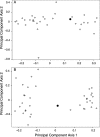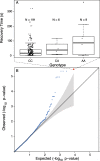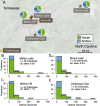Are personalities genetically determined? Inferences from subsocial spiders
- PMID: 31752670
- PMCID: PMC6873478
- DOI: 10.1186/s12864-019-6172-5
Are personalities genetically determined? Inferences from subsocial spiders
Abstract
Background: Recent research has revealed that polymorphic behavioral strategies shape intra-and interspecific interactions and contribute to fitness in many animal species. A better understanding of the proximate mechanisms underlying these behavioral syndromes will enhance our grasp this phenomenon. Spiders in the genus Anelosimus exhibit inter-individual behavioral variation on several axes: individuals have consistent responses to stimuli (e.g. bold vs. shy individuals) and they are subsocial (exhibiting extended maternal care and sibling cooperation) across most of their range, but they sometimes form permanent social groups in northern temperate regions. Here, we seek genetic variants associated with boldness and with social structure in a socially polymorphic population of the spider Anelosimus studiosus. We also develop preliminary genomic resources, including a genome assembly and linkage map, that support this and future genomic research on this group.
Results: Remarkably, we identify a small genomic scaffold (~ 1200 bp) that harbors seven single nucleotide polymorphisms (SNPs) associated with boldness. Moreover, heterozygotes are less common than expected based on Hardy-Weinberg equilibrium, suggesting that either assortative mating or selection against heterozygotes may be occurring in this system. We find no loci significantly associated with social organization. Our draft genome assembly allows us to localize SNPs of interest in this study and to carry out genetic comparisons with other published genomes, although it remains highly fragmented.
Conclusions: By identifying a locus associated with a well-studied animal personality trait, this study opens up avenues for future research to link behavioral studies of animal personality with genotype and fitness.
Keywords: Animal personality; Boldness; Genome assembly; Linkage map; RADseq; Social spiders.
Conflict of interest statement
The authors declare that they have no competing interests.
Figures



References
-
- Agnarsson I. A revision of the New World eximius lineage of Anelosimus (Araneae, Theridiidae) and a phylogenetic analysis using worldwide exemplars. Zool J Linnean Soc. 2006;141:453–593. doi: 10.1111/j.1096-3642.2006.00213.x. - DOI
-
- Avilés L. Causes and consequences of cooperation and permanent sociality in spiders. In: Choe JC, Crespi BJ, editors. editors The Evolution of Social Behavior in Insects and Arachnids. Cambridge: Cambridge University Press; 1997. p. 476–98.
-
- Avilés L, Madison W. When is the sex ratio biased in social spiders?: chromosome studies of embryos and male meiosis in Anelosimus species (Araneae: Theridiidae) J Arachnol. 1991;19:126–135.

